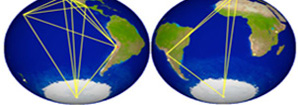Event Horizon Telescope Takes Data to Image Sagittarius A*

Tom Beal of the Arizona Daily Star has written an update on the Event Horizon Telescope Team's efforts: Dan Marrone, Feryal Ozel, and Dimitrios Psaltis are Steward faculty members involved in the project. The article describes the new data being taken in April 2017, the process of combining the data from telescopes across the globe, the process of getting all the data in the same place, and what happens when the data are reduced and analyzed.
Dr France Cordova, Director of the National Science Foundation said in an Apr 5 statement that "This week heralds an exciting and challenging endeavor for astronomy. The Event Horizon Telescope will seek to capture a first-ever image of the supermassive black hole at the center of the Milky Way, our home galaxy. Radio telescopes from around the world, anchored by the ALMA observatory in Chile, will work in concert to test some of physics' most fundamental theories. Success will depend on both a vast network of observations and analysis of voluminous data. NSF has funded this ambitious project for the past decade, including providing major funding for ALMA. We are proud to support such a visionary goal."
From a Scientific American blog on Apr 11: "Last Tuesday, the weather at the Event Horizon Telescope (EHT) command center in Cambridge, Massachusetts couldn’t have been much worse: it was rainy and barely 40 degrees F. But that wasn’t important. What mattered were the conditions in Hawaii, Arizona, Spain, central Mexico, northern Chile, and at the South Pole. Was the weather good in all those places simultaneously? If so, they had a shot at imaging a black hole."

For Public
Public events include our Monday Night Lecture Series, world-reknowned Astronomy Camp and Mt Lemmon Sky Center.

For Students
A good place to start if you want to become an undergrad major or grad student, or need to find our schedule of classes.

For Scientists
Find telescopes and instruments, telescope time applications, staff and mountain contacts, and faculty and staff scientific interests.




